Report
 }
}
Idea in Brief
We know from hundreds of examples nationwide that extraordinary student outcomes are possible at the individual school level. These persistent rays of hope shine through even in the most challenging of educational environments. Breakthrough results in student achievement occur when the significant challenges our students face are met with an even greater level of teacher talent and dedication—when talented individuals work together to do extraordinary things. Yet we also know that these kinds of schools don’t develop randomly on their own; an essential ingredient behind each of these success stories is transformational leadership.
Two years ago, we conducted an in-depth study focused on how school systems could develop more school leaders with the capabilities required to transform their schools. Progress since has been highly encouraging. But our most recent research has uncovered another critical challenge: While many school districts and charter management organizations (CMOs) are investing in programs to develop more transformational leaders, there is rarely a plan in place to deploy these people effectively within an individual school setting. As a result, development efforts are fragmented, our principals are overwhelmed, and teachers lack the support they need to progress as instructors in enough numbers to produce high-performing schools at greater scale.
The opportunity is clear: We need to commit to models of “distributed leadership” in our schools that establish a cadre of talented educators in each building who have end-to-end responsibility for the development of the teachers on their teams.
A growing number of schools are stepping up to the challenge and we’ve identified a set of best practices that are starting to succeed in the real world. Our most successful systems are on a path to develop more transformational leaders. The next step is to put them in distributed leadership models that will enable them to move farther and faster to transform their schools.
Table of contents
1. An opportunity for change
2. It takes a team
3. Adding more roles but not more leaders
4. A model for stronger leadership

A Model for Stronger Schools
Five principles of successful distributed leadership programs.
1. An opportunity for change
There is no substitute for a well-designed school leadership model—one that distributes end-to-end responsibility for improving teaching and learning.
A world of difference
Before she moved to a new school two years ago, Anna (not her real name) was like a lot of teachers trying to make the best of a difficult situation. Teaching third grade in a high-poverty urban school district posed a stiff challenge. But that wasn’t the problem. What troubled Anna was that most of the time she felt utterly alone in her effort to become a better teacher. Like any dedicated professional, she was ambitious and wanted to grow as an educator. She craved another perspective on her performance or simply someone to talk to about how to manage her classroom or structure a lesson. Most of the time, however, she worked in isolation, without any meaningful support or feedback. Her principal, who was responsible for evaluating all 30 teachers in the building, didn’t have time to offer much more than a cursory “good job.” And while the school had added a district-sponsored peer evaluator and an instructional coach, they were assigned to teachers who were really struggling—not those, like Anna, who were rated “effective” but were still motivated to improve and grow. The irony of this was demoralizing. “I never got coached because I was an effective teacher,” Anna said. “People were literally never in my classroom and that really bothered me. I wasn’t satisfied with where I was. I wanted to get better.”
That changed when the district asked Anna to move to another school to help launch a new model of “distributed school leadership.” The new school was in the same kind of neighborhood as the old one and students faced similar academic challenges. But Anna felt like she was in a different world. The whole point of the new leadership model was to support teachers across the spectrum so they could steadily develop their craft and improve student outcomes. In addition to spending half her time teaching her own students, Anna became a teacher leader in the new system with responsibility for facilitating the professional growth and development of a team of seven other teachers. Twice a week they huddle to analyze student data and then adjust instruction to meet student needs. Anna also meets with each of the teachers one-on-one to set long- and short-term objectives, spending time in their classrooms each week to help them achieve those goals. Anna herself is growing professionally by working with other “Team Leads” and through regular meetings with the school’s principal, who is on point to guide her development. The new leadership system brings its own set of challenges and nothing about her job is easy. But Anna finally feels like she has the support she needs to help her students—and those of her team members—learn and achieve.
Looking for a better way to lead
For Anna, the move to a school with a distributed leadership model was transformational. It meant feeling energized to make a difference, rather than isolated and overwhelmed in what often felt like a dead-end job. Her story, which emerged from a joint Bain & Company and Bridgespan Group research effort in collaboration with 12 school systems nationwide, highlights what a growing number of educators see as a critical missed opportunity: While it’s widely understood that strong leadership is vital to helping students succeed, most school systems lack a model that establishes more leaders in each school with end-to-end responsibility for teacher development and student outcomes. Instead, responsibility for improving teaching and learning typically rests in the hands of one overworked principal and an equally overworked assistant principal (AP). The result is that principals are overwhelmed, efforts to develop better teachers are badly fragmented and the lack of support leaves teachers fending for themselves, all of which stifles their progress toward becoming better instructors.
We surveyed more than 4,200 teachers, assistant principals and principals at school systems of varying sizes throughout the United States. We performed in-depth interviews with teachers, principals and system-level leaders. Our research demonstrates clearly that few school systems distribute leadership within individual school buildings in ways that are common among most successful organizations—public or private. While many districts are investing heavily in new leadership roles—upwards of 25% of teachers have taken on a “teacher leader” title, for example—our research shows that very few of these additional leaders feel responsible for the performance and growth of the teachers they lead.
Many school systems recognize the need to reduce the instructional leadership burden on principals. They have tried in recent years to create more leadership capacity through a wide variety of initiatives such as engaging more teachers in leadership roles, adding APs and hiring instructional coaches. They have also spent heavily on professional development programs aimed at helping teachers grow in their roles. But none of these efforts is a substitute for a well-designed school leadership model—one that distributes primary responsibility for developing instructional excellence among a team of skilled, empowered educators who have the time and authority to work closely with teachers on a day-to-day basis. Despite their best efforts, most schools are falling short of this standard and it is affecting their ability to engage teachers in helping schools—and students—improve.
We believe a significant opportunity exists to introduce leadership models that give teachers the support they need to produce dramatically better outcomes. To help define what those models should be, we set out to identify what leadership structures exist in schools today and to assess how well those models are working. We explore these findings in Chapter 2 and 3. Many of the school systems in our research are experimenting with more effective leadership models in their schools and the results, while early, are encouraging. While most of these efforts are new and no one structure has yet proven empirically superior, our research has highlighted five key principles we believe should underlie any robust school leadership model. In Chapter 4 we provide a detailed discussion of these principles and how to shape them into a workable leadership model.
2. It takes a team
Historically, school systems have not focused on developing strong leadership teams. They're still Waiting for Superman.
The drumbeat of negative news and statistics surrounding the American school system can often seem overwhelming. The litany has become familiar: The US continues to lag other developed nations in reading, math and science. Millions of students leave our public schools unqualified to compete for jobs in an increasingly global workforce. The outlook is especially bleak for the more than 16 million children raised in poverty: Fewer than 10% of students in the bottom income quartile graduate from college compared with nearly 80% of students in the top income quartile.
Yet as we described in our 2013 report, these dire statistics obscure the fact that hundreds of individual schools are producing dramatically better outcomes. Numerous studies have documented the standout achievements of more than 250 high-performing schools in traditional urban school districts across the US. At schools like Martin Luther King, Jr. Early College in Denver and Berryhill School in Charlotte, students in poverty are learning more, graduating from high school in greater numbers and increasingly succeeding in college. They are demonstrating that all students can achieve even under the most difficult circumstances (see Figure 1).

The power of strong leadership
What do these exceptional schools have in common? The clearest answer is great leadership. While debate rages over which policies and reforms will best drive student outcomes, the power of great school leaders to make an enormous difference in the buildings they serve is not controversial. “Principals shape the environment for teaching and learning,” said former National Education Association President Dennis Van Roekel. “The most effective principals create vibrant learning communities where faculty and staff collaborate to help every student fulfill his or her potential.”
Our own research showed that a full 96% of respondents agree that great leadership is an essential ingredient in making a school successful (see Figure 2). And study after study has reinforced this point. “There are virtually no documented instances of troubled schools being turned around without intervention by a powerful leader,” concluded a 2004 University of Minnesota study commissioned by the Wallace Foundation. A 2012 study of Texas schools led by Hoover Institution economist Eric Hanushek documented that the highest-quality principals drove the most lasting improvements.
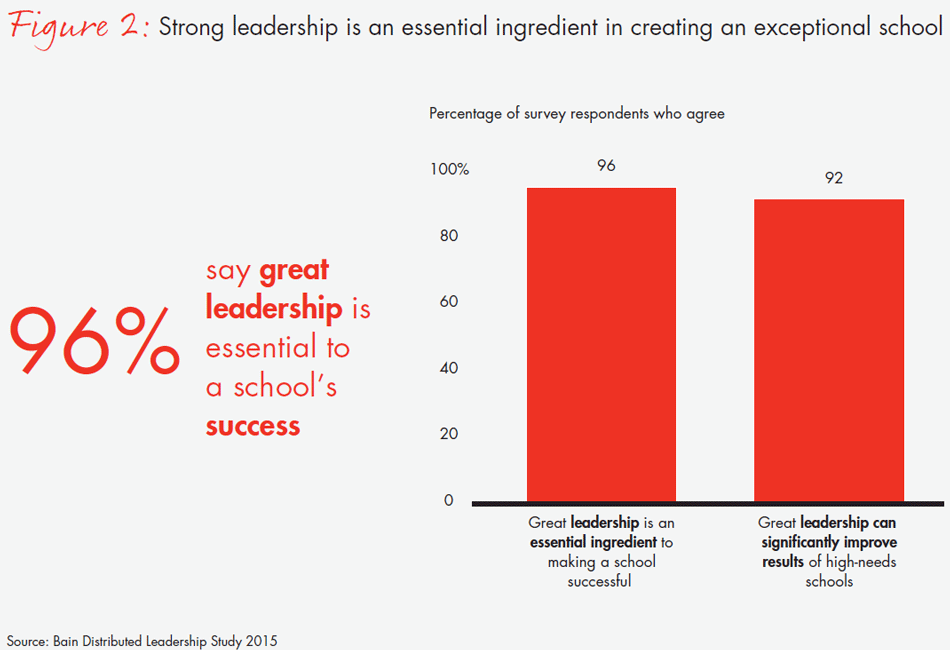
A lack of leadership models
But if filling the principal’s role with strong leaders is the first step in raising the leadership capacity in our schools, the critical next step is creating the kind of leadership model that can magnify the principal’s effectiveness. The core objective of any school is to provide high-quality instruction: fostering both excellent teaching and a learning environment in which students can thrive. That requires the kind of day-to-day coaching and support that is most effective when leaders work closely together with their teams. We know from our 40 years of work with leading private sector companies that most large organizations achieve this by creating management structures that distribute responsibility for outcomes among an empowered group of talented individuals specifically tasked with coaching and developing others. Senior leaders are directly responsible for the development and performance of their direct reports. But they then count on those people to lead their own teams.
Our research demonstrates that most schools lack this sort of distributed leadership model. Instead, the vast majority of all instructional leadership responsibilities rest solely with the principal. A full 96% of principals we studied said they were responsible for the performance and growth of the teachers in their buildings, and 82% said they were the primary person responsible (see Figure 3). It is critical, of course, that principals take responsibility for the overall performance of their schools. But there is a difference between overall responsibility and hands-on accountability for the personal development of every adult in the building. One principal in a large urban district described his role this way: “I am the instructional leader of my campus and the performance and growth of teachers is my responsibility. If teachers fail, I fail.”
Historically, school systems have not helped principals develop and implement management structures that would distribute those responsibilities more broadly. When a principal takes the helm of a school, he or she usually sticks with the structure in place, which often means personally taking on the bulk of the management load.
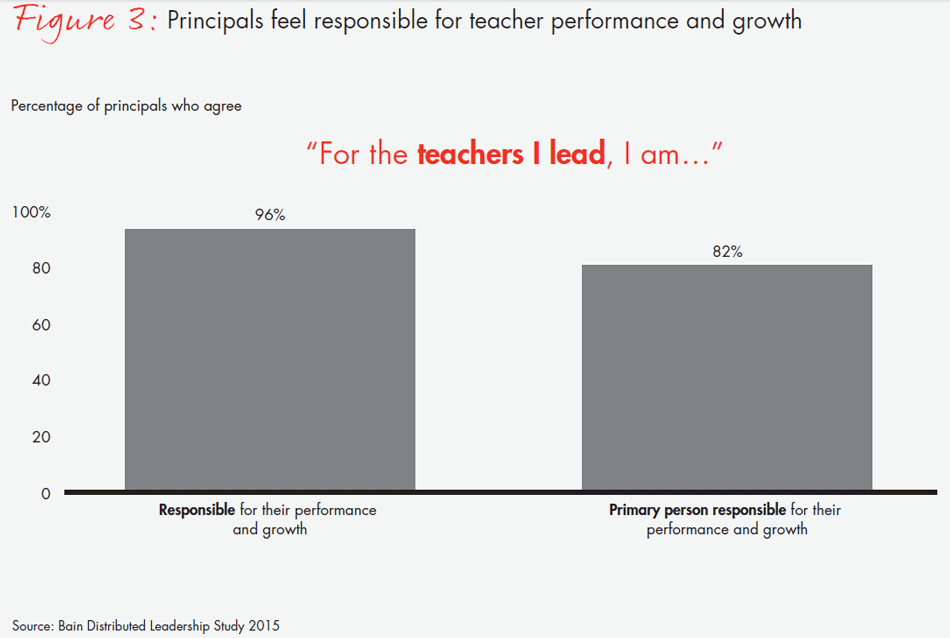
One elementary school in a large urban district we studied was typical. There, the principal and one assistant principal are responsible for monitoring and reviewing all 54 teachers and 93 total adults in the building. The district also holds them directly accountable for the outcomes of all 570 students in pre-K through fifth grade. This is an onerous “span of control” by any other industry standard, but not unusual for a public school. The average principal in our research is directly responsible for the performance and development of 37 teachers, as well as additional non-instructional staff. That compares to a span of five people for the average manager of highly skilled professionals like accountants or human resource specialists. Even managers of less skilled employees, like call-center workers or janitors, typically have direct responsibility for only around 15 people (see Figure 4).

The principals in our survey are not only responsible for large numbers of people but they also take on a long and time-consuming list of instructional leadership activities (see Figure 5). That often dilutes their ability to have the kind of meaningful day-to-day interactions that truly foster development. In another large urban school district we studied, for instance, the evaluation process stipulates that every teacher must receive 10 spot observations each year from his or her direct supervisor in addition to a formal observation and evaluation. On average, that means the principal and typically one AP take responsibility for nearly 220 observations each throughout the year. This results in cursory, 15-minute stop-by visits followed by “feedback” in the form of a filled out checklist. While such drop-in observations can be helpful if well done, these types of interactions in isolation are too brief and one-sided to encourage growth.
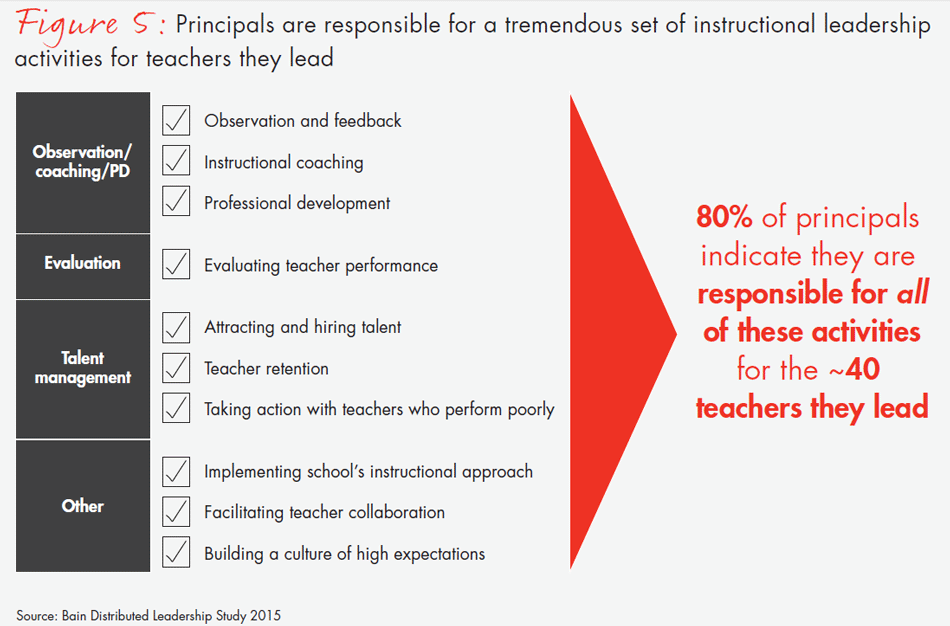
When we asked teachers about the feedback they received, many acknowledged that they were observed and evaluated several times a year. But they had no real working relationships with those who evaluated them (usually the principal) and had few, if any, helpful conversations about how to improve their teaching. This leads to a lack of trust and leaves many teachers deeply unhappy about their prospects. “I’ve been evaluated five times a year for the last eight years but I don’t know why,” said one teacher. “My rating never changes. No one has suggested I do anything differently. No one has ever explained to me why we do this or what the point of the whole process is.”
Not surprisingly, many principals are deeply frustrated by a leadership model that stretches them so thin. Being on point to develop and give feedback to 20, 30 or even 40 teachers is simply overwhelming. “Although giving feedback and supporting teachers is extremely important, there are times when operational tasks prohibit me from spending the quality time with teachers needed to improve their instructional practices,” one principal told us. Another summed it up this way: “I feel the job is unsustainable and unhealthy.”
Waiting for Superman doesn’t work
Many school systems recognize they have a problem. To borrow the title from the searing 2010 documentary, they know they’ve spent too much time Waiting for Superman and not enough effort developing better leadership models. “Our initial focus was putting in place principals who could do everything. We were looking for unicorns,” said Jason Kamras, chief of the office of human capital at District of Columbia Public Schools. John Davis, the DC chief of schools, observed that an exceptionally talented principal can sometimes make a substantial difference in the short term, but the effect rarely lasts in the absence of more support. “Schools built around a single extraordinary leader never sustain their success,” he said. “When Superman or Superwoman leaves, it all falls apart.”
In the face of such complaints, school districts and CMOs throughout the country have responded aggressively by making significant investments in professional development initiatives. A recent study involving 10,000 teachers by TNTP, the national teacher training and advocacy group, found that many districts are spending upwards of $18,000 per teacher per year on professional development—sometimes more than the budget for transportation, food and security combined. In one district we worked with, teachers were being pulled away from their classrooms for up to 25 days a year for district-wide professional development sessions.
There’s no evidence this heavy spending and time investment is paying off. While newly minted teachers show relatively strong development for the first few years on the job, the study demonstrated that they tend to plateau or decline after that (see Figure 6). Only three out of 10 teachers improved each year, and nearly half the teachers with 10 years of experience or more were rated below “effective” in core instructional skills. “The answer isn’t to tweak the current approach,” said TNTP Chief Executive Officer Daniel Weisberg. “We’re not going to find the long-lost formula for effective professional development. We need to start by taking a fresh look at school leadership roles and how educators work together to improve teaching and learning in their buildings.”
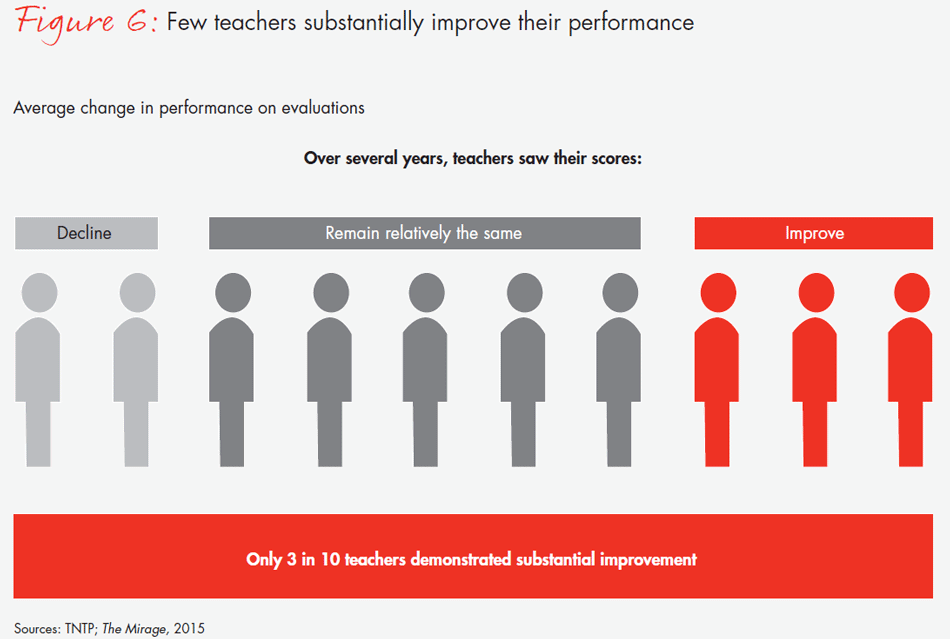
Given these findings, it is hardly surprising that many teachers feel more judged than supported. They see the constant calls for improvement as unfair criticism, not a motivational call to action. Few view their school as a good place to build their career or develop their craft. When asked if they were likely to recommend their school to others as a good place to work, only 27% said they would (see Figure 7). In fact, based on the Net Promoter Score®, a well-accepted measurement of loyalty, teachers scored negative 18—well below their peers in higher education and worse than even government workers (see Figure 8). “I would not recommend my school as a place to work because there is a lack of support, leadership and collaboration,” said one teacher in a large urban system. Concluded another: “This is not a place to grow as an educator.”
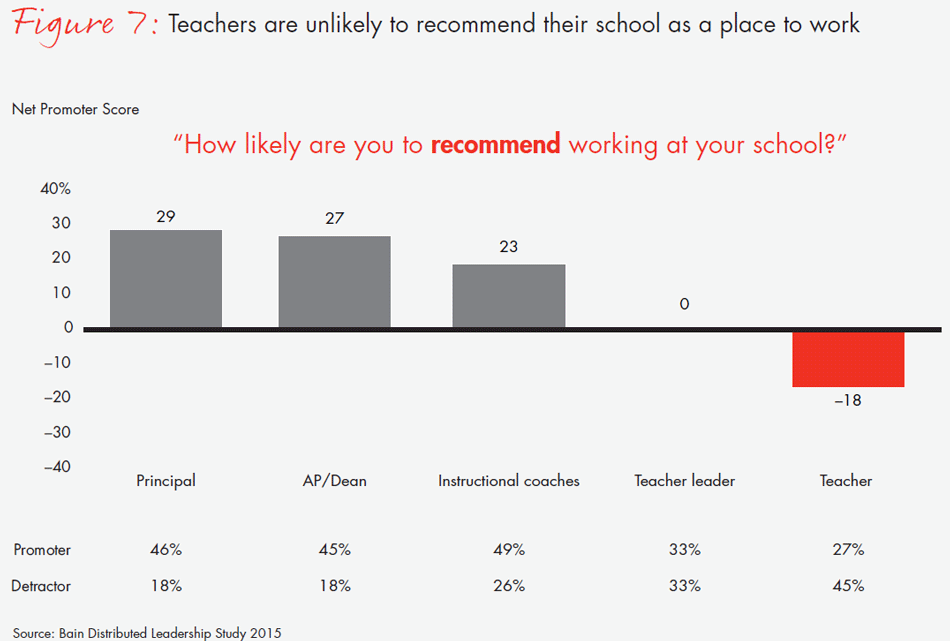

3. Adding more roles but not more leaders
School systems rarely design and launch leadership roles with an integrated vision of how they will work together.
A major objective of our research was to pinpoint what some of the nation’s largest school systems are doing to identify better leadership models. In addition to the professional development spending we discussed in Chapter 2, most major districts and CMOs are devoting significant resources to creating more leadership positions in their schools—both to give their teachers new opportunities outside the classroom and take the load off principals. Unfortunately, the increased levels of investment are not helping most teachers significantly improve their craft.
All too often we are investing in one-off roles and a broad menu of professional development efforts without a clear vision for how schools should be led or how that model will improve teaching and learning. Simply put, we aren’t expecting the right things from our leaders and we aren’t setting them up for success. “We have so many adults in the building,” said Brian Pick, chief of teaching and learning for the DC Public Schools, “we just need to use them differently. We need to be bolder in how we think about leading our teachers.”
"Seeing what sticks"
Systems are working hard to expand the leadership capacity in their schools by investing in a long list of different leadership roles. When one large urban system took stock of its activity recently, it found that it had created some 40 different types of roles and that more than 35% of its teachers held one of them. In another district we studied, the schools averaged 12 additional leadership positions for each principal in the system (see Figure 9).
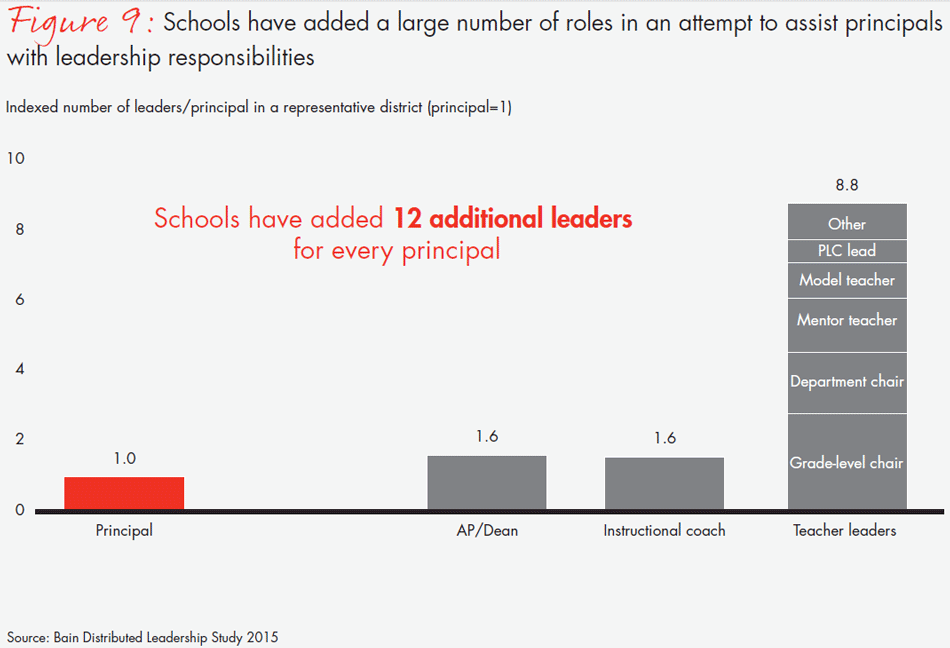
Teacher leader roles have expanded the fastest. Schools use these positions to retain strong teachers by recognizing them, rewarding them and giving them new opportunities to grow. The state of Iowa is a good example. In 2013, Iowa’s Department of Education launched a statewide initiative to invest $150 million a year in promoting teacher leadership roles with a stated goal of retaining the best teachers. The program intends to create better long-term professional development opportunities and promote collaboration among teachers so they can learn from each other. It increased compensation levels and required that each school make a good-faith effort to place at least 25% of its workforce in the new leadership roles.
School systems are also investing in professional learning communities (PLCs)—groups of teachers brought together to improve collaboration, coordinate work and share the best instructional practices. The Fresno Unified School District in California, for instance, has created 700 “Accountable Communities,” designed to support a common set of instructional practices. Teams vary in size from 3 to 10 and are organized around either a grade level (elementary school) or a subject like social studies or math (middle and high school). Each has an assigned “Lead Teacher,” who receives a $2,000 stipend and is responsible for facilitating team meetings in which he or she passes along relevant information from district-wide professional development sessions.
Instructional coaches are another common role schools use to bolster their leadership ranks. The Spring Branch Independent School District near Houston moved to a model with at least one instructional coach for each school in the district and has invested in regular training in addition to an intensive training program for coaches called “Teach to Lead.” Spring Branch and other systems are betting that instructional coaches can play the vital development role principals and APs are too stretched to take on. “I don’t have the kind of informal time and relationship with my principal that I do with my instructional coach,” one teacher in Dallas explained. “She (the principal) is just too busy. I see my coach more frequently and that helps me work on specific skills. It works really well when the teacher is open to being coached.”
Even with all of this additional leadership capacity, however, teachers still say they aren’t getting the help and support they need. Why not? The answer is that school systems rarely design and launch these roles with an integrated vision of how they will work together to support the school’s overall mission. More often, “we are just throwing things at the wall and seeing what sticks,” said the human resources director at one midsize school district. Schools tend to deploy these roles ad hoc to provide professional development opportunities, fill short-term gaps or address special projects. They rarely expect leaders to feel directly responsible for improving the teaching practices of those they lead. Even when they do, they give leaders no real time or authority to help teachers improve their practice. As one district superintendent put it, “Today people are just falling into roles. We should be using these roles more intentionally to develop people but we’re not.”
Teacher leaders: Facilitating, not leading
Teacher leader roles can be a valuable way to give teachers opportunities to grow outside the classroom. They expose teachers to new responsibilities and give them a chance to use their skills to help peers succeed. But more often than not, teacher leaders aren’t given specific responsibility for leading and developing other teachers in the building. And most don’t feel accountable for the performance of those they are working with. A full 84% report their duties are facilitating meetings or passing on information from supervisors, tasks which vastly outweigh other development-focused activities (see Figure 10). “Although I am a team leader, my sole responsibility is to communicate information from coaches and principals to my team,” one teacher leader in a large urban district told us. “No other primary reason has been given to me.”
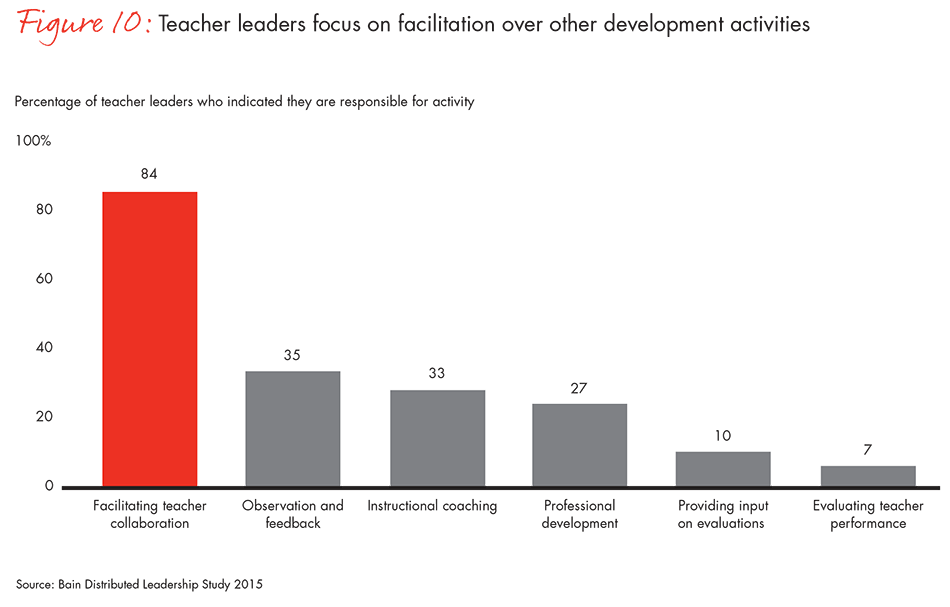
Only 22% of the teacher leaders in our survey said they felt responsible for the performance of the teachers they lead and just 10% said they were “primarily” responsible for that performance (see Figure 11). “I assist teachers, but I am not responsible for their performance,” said one teacher leader at a large urban school district. Similarly, only 32% of the teacher leaders felt responsible for the performance of students taught by the teachers they lead and only 19% said they were accountable for those outcomes (see Figure 12). One teacher leader in a large urban district drew a clear line: “I am not responsible for the learning and development of the students taught by these teachers, nor do I feel empowered to impact the learning and development of these students.”
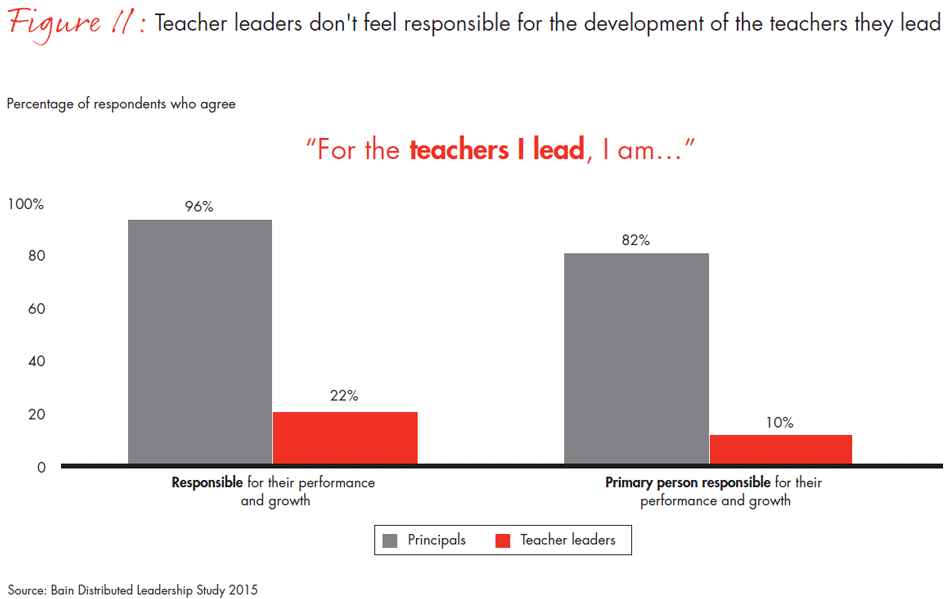
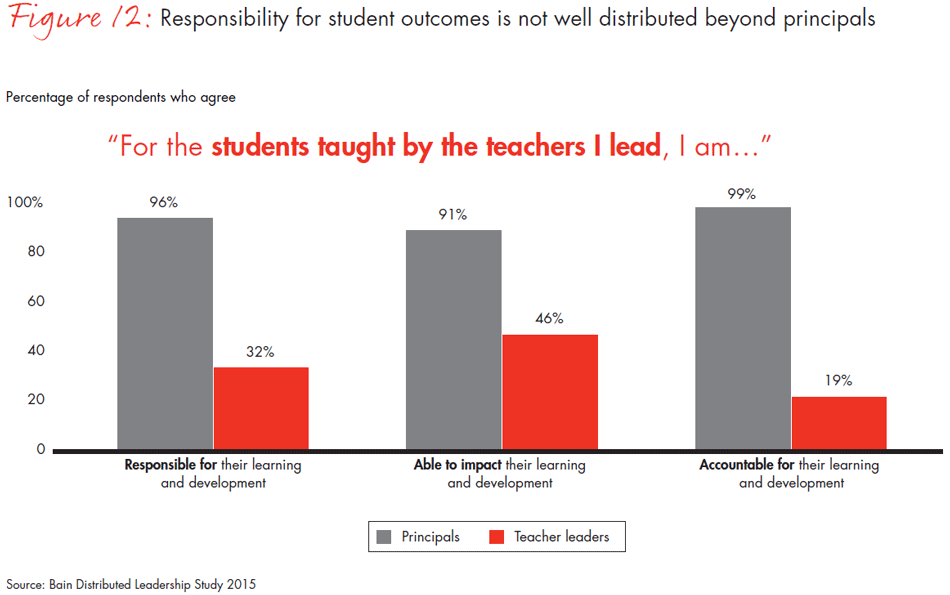
Even if teacher leaders did have more authority, these roles too often leave them searching for time in an already crammed schedule to work closely with those on their teams. Fully two-thirds of the teacher leaders in our research indicated that they are not given the time or resources to lead their teams effectively and they rarely receive extra compensation for their added responsibilities (see Figure 13). “I do not have time in my schedule to be responsible for teacher performance and growth,” said one teacher leader. Said another: “I feel as though I have very little impact because I have been unable to observe what most of the teachers do in their classrooms. Therefore I feel as if I have no real authority.”
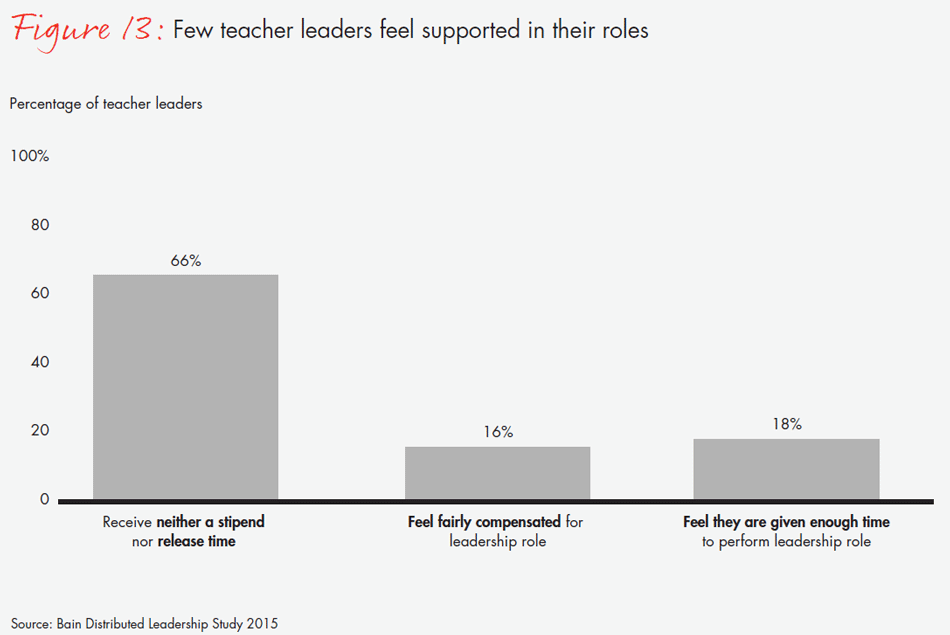
Seeing these roles in action helps explain why they are not more effective. Two years ago, for instance, one large urban school district in our study instituted “grade-level leads” in its elementary schools and “department leads” in its middle and high schools. These positions included no stipends, but they did give the teacher leader “release time” of one period per day to lead meetings with their teams and communicate information from the district. The goal was to create more leadership capacity within the schools.
Teacher leaders in the district viewed the move positively. It added to their sense of value and enhanced communication within the building. But few teachers reported having any real impact on teacher performance, and they aren’t even sure they are supposed to. “Growing and developing teachers is not my expected role. I just have the title,” said one teacher leader. Most reported that they have neither the authority nor the time to visit classrooms, provide real-time coaching, evaluate performance or suggest changes to their colleagues. Teachers do share ideas in department or class-level meetings, but there is no mechanism to work more closely with other teachers inside the classroom. One principal said she wished the teacher leader positions were structured as “real roles” where a teacher who knows his or her craft well could act as a player coach or a “demo teacher.” But “my role is that of a facilitator,” said one teacher leader. "Teachers have no incentive to follow the advice I give or implement the suggestions I make.”
PLCs: Collaboration, not coaching
Many school systems have turned to professional learning communities as a means to provide a more structured form of deliberation and collaboration. At their best, PLCs can be highly rigorous and well run, creating a valuable forum for discussing core instructional issues and providing teachers much-needed support and counsel. Typically, they are also designed around teams doing work together, which can help promote peer-to-peer learning.
As valuable as PLCs might be in fostering collaboration, they usually fall short of plugging the leadership gap. That’s because they aren’t typically led by an empowered leader with the responsibility, time and authority to help those within the community materially improve their instructional practice. They rely on meetings and group discussion rather than empowering the PLC leader to work closely with team members through observation, coaching and feedback. In our study, 38% of the PLC leads said they felt responsible for the performance of the teachers in their group and just 32% said they are responsible for those teachers’ student outcomes (see Figure 14). Only 12% said they were the primary person responsible for teacher performance.
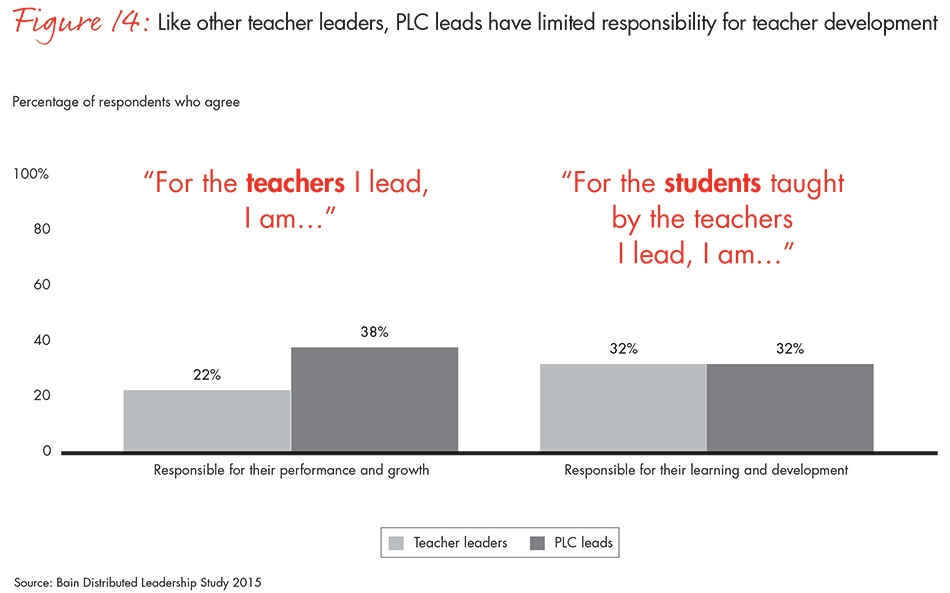
One urban district we worked with had invested heavily in PLCs. The superintendent reflected that the PLC leaders were skilled at facilitating meetings and communication. But he hadn’t empowered them to assume responsibility for the development and coaching of the teachers on the team. Now he thinks that may leave room for improvement. “In hindsight,” this superintendent said, “I would have set it up differently, asking our leaders to focus more on development and coaching. We have the structure in place but we can’t stop here.”
Instructional coaches: Support, not leadership
By definition, instructional coaches play a significantly different role than either teacher leaders or PLC leads. School systems have deployed them widely—often one or two per building—precisely to provide the observation, coaching and feedback teachers aren’t getting otherwise. Teachers report that these one-on-one relationships can be very helpful in terms of skill development and growth. And unlike teacher leaders and PLC leads, instructional coaches do assume many of the instructional development responsibilities that typically fall to principals—from observation and feedback to facilitating professional development sessions (see Figure 15).

But like teacher leaders, instructional coaches are not plugging the leadership gap at most schools. While our research shows they have more time than a typical teacher leader, they lack the mandate and the authority to truly lead. Despite having such a focused professional development role, one-third of the instructional coaches in our research did not feel responsible for the growth and development of teachers they work with, and only 36% said they were accountable for their growth (see Figure 16). Why such a gap between what their role appears to be on paper and the responsibility they feel for outcomes? The root cause is that while instructional coaches can observe, coach and provide feedback, they typically aren’t empowered with the ability to compel performance, which is well understood by those they are trying to help. “I love coaching teachers but I’m frustrated by the limits of my job,” said one coach at a midsize urban district. “I can make observations and give positive feedback but when it comes to improving instruction, all I can do is make suggestions. My coaching has no teeth.”
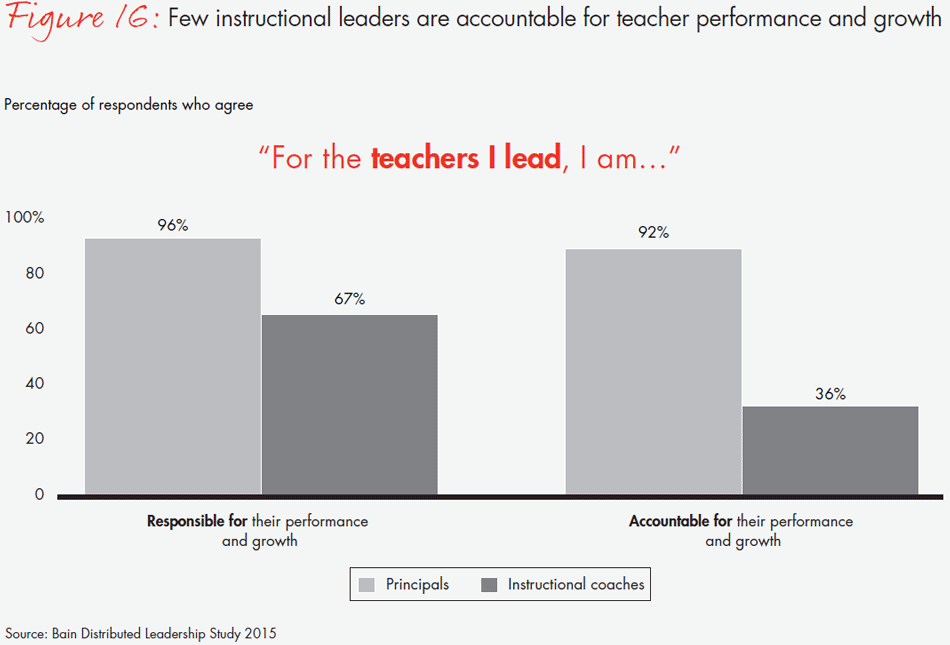
Systems set up instructional coaching roles this way because of a widespread view, unique to education, that responsibility for coaching and evaluation should be separate. Conventional wisdom is that by creating a “safe space” for coaching, teachers will be more receptive to feedback and better prepared to develop their craft. Officials at one midsize CMO said that when they first set up an instructional coaching program, teachers asked for a clear line between those who were evaluating (principals and APs) and those who were coaching (instructional coaches). Coaches didn’t communicate with evaluators about what they were working on with teachers, and vice versa.
Teachers loved the customized, one-on-one nature of the program but it eventually led to confusion and became distracting as instructional coaches and principals gave teachers conflicting messages. This is happening in systems all over the country. It represents a missed opportunity to realize the full benefit of the time and effort schools are investing in coaching and evaluation. The messages teachers receive from the multiple individuals involved are often out of sync, evaluation is seen as disconnected and unsupportive, and coaching loses its relevance and power.
A need to break new ground
School systems have increasingly recognized that asking principals to assume direct responsibility for the development and support of approximately 40 teachers is not an effective approach. That breadth of direct leadership responsibility has not worked in any other sector and it’s not working in education. Teachers are left feeling isolated and unsupported and, over time, have less and less faith in their ability to achieve far better outcomes with their students. School systems have been investing to close this gap but all too often those investments have stopped short of creating effective leadership capacity. Additional leadership roles are weakly structured and focused too far from the core activities of teaching and learning inside the classroom. Rarely are these roles designed to fit into an integrated model of how the school will be led.
The good news is that a number of the systems we have studied are breaking new ground in their efforts to build more effective school leadership models and their results so far are encouraging. The key question is this: How can school systems design and implement distributed leadership models that empower leaders with the time and authority to help schools deliver on their most important objectives: better teaching and learning?
4. A model for stronger leadership
Distributed leadership provides the hands-on, day-to-day coaching and support that helps teachers make a real difference in their students’ lives.
The leadership challenges we’ve highlighted are significant and widespread but they are by no means unsolvable. Many of the districts and CMOs we’ve studied are making meaningful progress toward deploying promising new leadership models. They’ve taken a variety of approaches but those having the most success focus on establishing more leaders with “end-to-end” responsibility for all aspects of a teacher’s professional development: setting specific goals, observing and giving feedback, inspiring and motivating, facilitating high-quality collaboration and creating strong alignment with performance evaluation. Such leadership models are rare today. Teacher support is too often fragmented: Some leaders just provide coaching, some focus only on evaluation, some work on professional development and others facilitate collaboration.
Our research has focused on which factors the most promising models have in common. That, coupled with our own extensive experience helping organizations in many other sectors design better leadership models, led to five key principles we believe are critical to designing and implementing the kind of robust distributed leadership model that can help transform a typical school into an extraordinary one (see Figure 17).
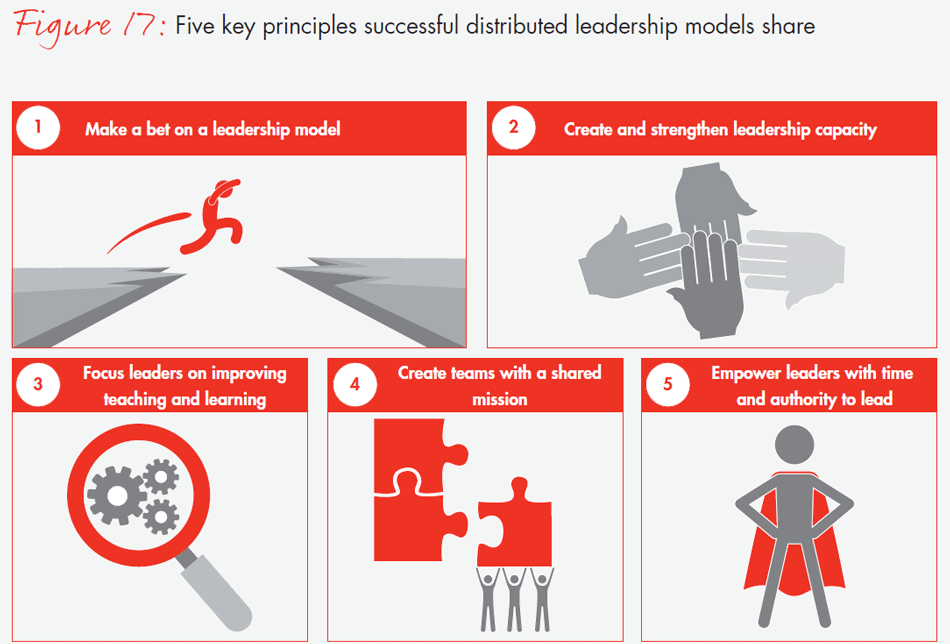
The systems we studied are early in their journey toward distributed leadership, and it’s too soon to measure their success through student outcomes. Teachers working in schools with distributed leadership do, however, feel more positive. Denver Public Schools (DPS) has seen significant improvements in teachers’ morale in pilot schools using a distributed leadership model. The Net Promoter Score of teachers in pilot schools is 47 points higher than for all teachers we surveyed and significantly higher than for teachers in other Denver schools. In a recent DPS survey, 85% of teachers said their Team Lead is successful at both evaluating their practice and coaching them to improve. And 84% are glad that their school adopted a distributed leadership model. At the Sanger Unified School District in California, which has the longest established distributed leadership model of all the systems we studied, the teacher Net Promoter Score was an impressive 54. These differences in teacher advocacy are dramatic and bode well for improvements in teaching and learning.
Principle 1: Make a bet on a leadership model
An effective distributed leadership model is a comprehensive blueprint for how a school will resource and deploy leadership to deliver on its core mission—improving the quality of teaching and learning. A great design answers three sets of critical questions including:
- Leadership roles: What will the core leadership roles be and what responsibilities will those leaders have?
- Structure: How will leaders be deployed to support teams of teachers?
- Systems and processes: How will planning, observation, feedback and coaching work? Who will own evaluations and who will have input?
Designing such a model is a major undertaking. It requires deciding on a high-level approach or multiple approaches to test, and then building and refining the supporting systems—all of which takes significant time and effort (see Figure 18). Many systems have taken a pass on deciding which leadership model would be best for their schools. Some do so because they think it’s better if principals decide for themselves how best to organize and lead their schools. They see every school as unique, with its own context and leadership requirements. Others believe the system should identify and share a best practice school leadership model but are daunted by the task and struggling with how to begin.
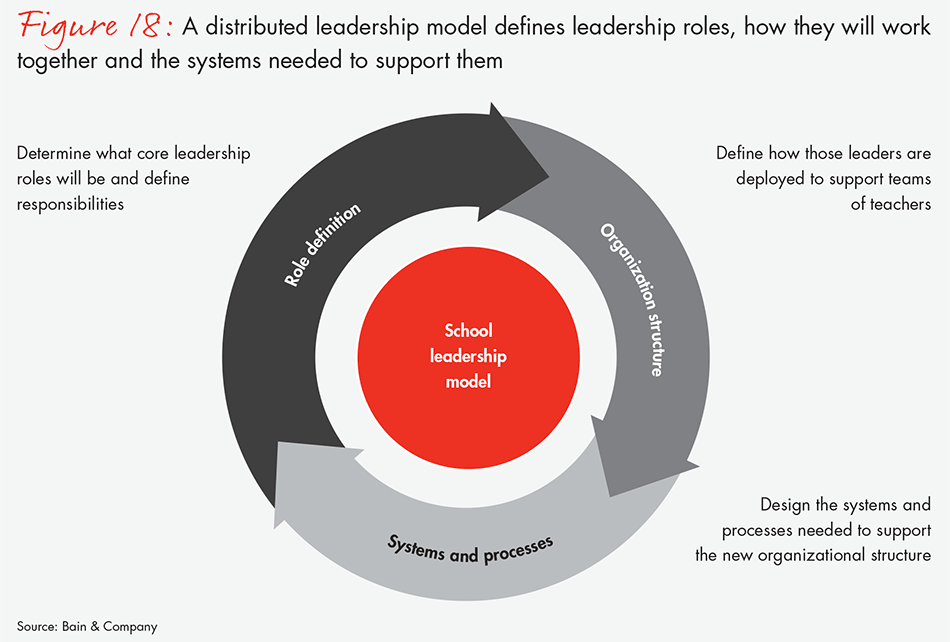
The most successful efforts we’ve seen are actively supported by the center and are largely consistent across the system. Some room for local customization is important, but the intent should be to design a model that the entire system can bet on. We don’t ask principals to design the IT system from scratch or write their own textbooks. The school leadership model is no different—it is a tool that is best designed, with plenty of principal and teacher input, to serve the system as a whole with latitude for school-level customization.
One of the clearest reasons a common approach makes sense is that it is simply impractical to ask principals to design and put in place a robust leadership model on their own. As we discussed in Chapter 2, we ask for extraordinary effort from our principals and they usually have little time—or the relevant experience—to both design and implement a new leadership model in their schools. Distributing leadership for the first time is an enormous change and, like all big changes, it requires significant time and energy, even when putting in place a proven and well-defined model. Asking our principals to initiate that change and design the model on their own effectively guarantees they will stick with the status quo. Most won’t take on the challenge or expend the political capital necessary to put an effective distributed leadership model in place.
A common design also takes advantage of the fact that systems are much better positioned to look across all their schools to see what is working and what needs adjustment. As each school implements the model, the central office can codify best practices and share what it learns across the system. Sanger in California, for instance, set out a decade ago to change the leadership model in every one of its schools. It chose an approach designed to cultivate multiple leaders in each building who feel truly responsible for developing the teachers they manage and improving the outcomes of their students. Sanger leadership agreed on a common model that centers on Team Leads—teacher leaders who work with teams of teachers in PLCs. But they left the details of how to roll it out to the schools. Principals initially implemented as many different versions of the Team Lead/PLC model as there were schools in the district, but eventually they began to standardize on a single model that incorporated the best features of each one. “In the beginning it allowed us to be very innovative and have unintentional pilots of different approaches,” said Sanger Area Administrator Tim Lopez. “And then we gravitated to what folks were doing well and things look more similar now because we know what works.”
The best organizational leadership models are purpose-built to accomplish the organization’s most critical mission. While every school has its differences, they all share the fundamental mission of improving teaching and learning. Groups of elementary, middle and high schools in a given system are more alike than unalike when it comes to addressing this core challenge. Standardizing as much as possible around a well-developed model makes deploying and managing it easier and more effective. If schools have similar roles and leadership processes, the system can better align critical support functions such as talent development, compensation and evaluation.
Denver Public Schools learned the value of betting on a common distributed leadership model when it set out to boost the leadership capacity in its schools six years ago. Denver had no shortage of leadership roles—more than 35% of its teacher ranks had some sort of teacher leadership title—but because each principal set up a separate leadership model, a title in one school might mean something entirely different in another. There were pockets of excellence, but it was difficult to know what was working and why.
Recognizing that it needed a more systematic approach, Denver devised a pilot leadership model that was 80% “tight” (common across the system) and 20% “loose” (adjustable based on local needs). It centered the model on a set of clearly defined teacher leadership roles with processes specifically designed to support and strengthen them—including precise definitions of responsibility, a standard set of expectations and common compensation structures. Individual schools could tailor the model around things like the amount of release time teacher leaders received and the composition of teacher teams. But every school’s version of the model had the same set of working parts, making it easier for DPS to distill what it learned from the pilots and share best practices across schools.
Denver started by piloting its model in just 14 of its 185 schools. After the initial pilot, the district made modifications (e.g., how it organized teacher teams) and then added 26 schools in 2014–2015 and 31 more in 2015–2016, for a total of 71 schools. Each wave has helped the district fine-tune the model further (see Figure 19).
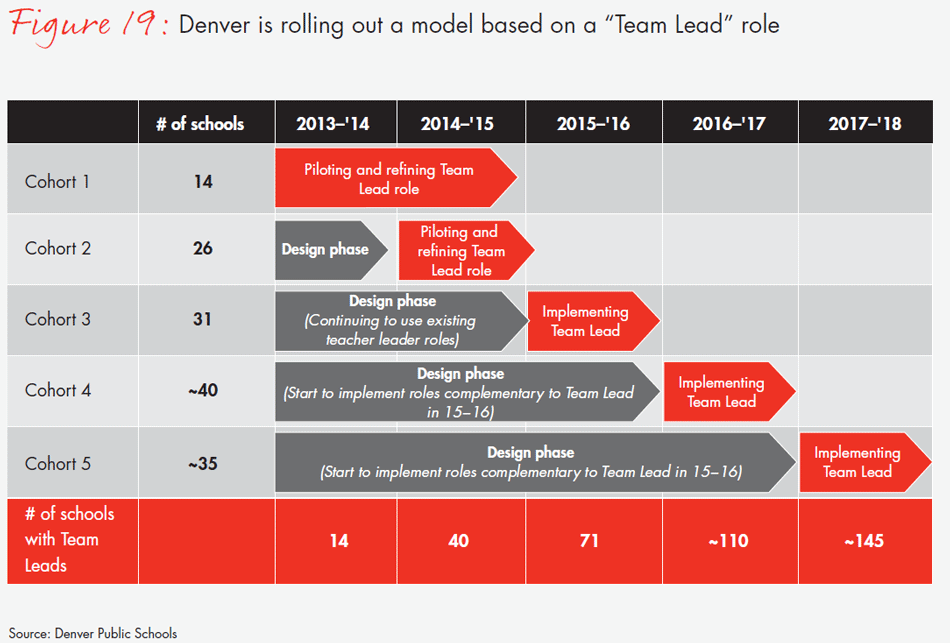
Denver Superintendent Tom Boasberg underscored how important getting behind a common approach has been: “Fundamentally redefining roles in schools that have been static for over 100 years presents an enormous change-management challenge. Absent a clear vision, a set of vitally needed professional-learning supports for teacher leaders and principals, and peer-to-peer reinforcements among schools, all of the forces that are against change would defeat the possibility of significant progress in all but the most resolute of schools.” While DPS began with a series of pilots, it was the district’s bet on a system-wide approach that ultimately allowed it to scale what worked best. “By picking a model, while allowing for some flexibility at the school level, we’ve been able to focus our efforts and better support our principals and teachers in making this change,” Boasberg said.
Principle 2: Create and strengthen leadership capacity
The school systems we’ve studied are developing a number of promising models for elevating and strengthening leadership roles. Some focus on increasing the number of APs in each school; others are betting on teacher leaders. The common thread in the models that are showing the most promise is strengthening the amount and quality of leadership capacity focused on the core mission of teaching and learning within each school building. The central question is where to allocate scarce resources.
The choice of which roles to prioritize depends on a school system’s overall structure and objectives. The systems that decide to add more APs, for instance, are usually fast-growing charter management organizations that need robust talent pipelines to produce more principals for an increasing number of schools.
A good example is Green Dot Public Schools, a CMO based in Los Angeles. Green Dot enrollment has grown more than 10 times since 2003. By adding more APs and training them to be instructional leaders capable of mentoring and developing better teachers, the system has both strengthened the leadership capacity in its current schools and created a rich talent pool to draw on when it opens new schools.
A typical Green Dot school with 540 to 620 students now has one principal and two APs. That means none of the three top leaders has more than 13 teachers on his or her team. Green Dot ensures that the APs are well trained through a rigorous program of mentoring and professional development. Its model ensures that principals don’t saddle APs exclusively with administrative duties. The idea is to focus them on developing the instructional effectiveness of their teams while preparing them to one day lead schools of their own (see Figure 20).
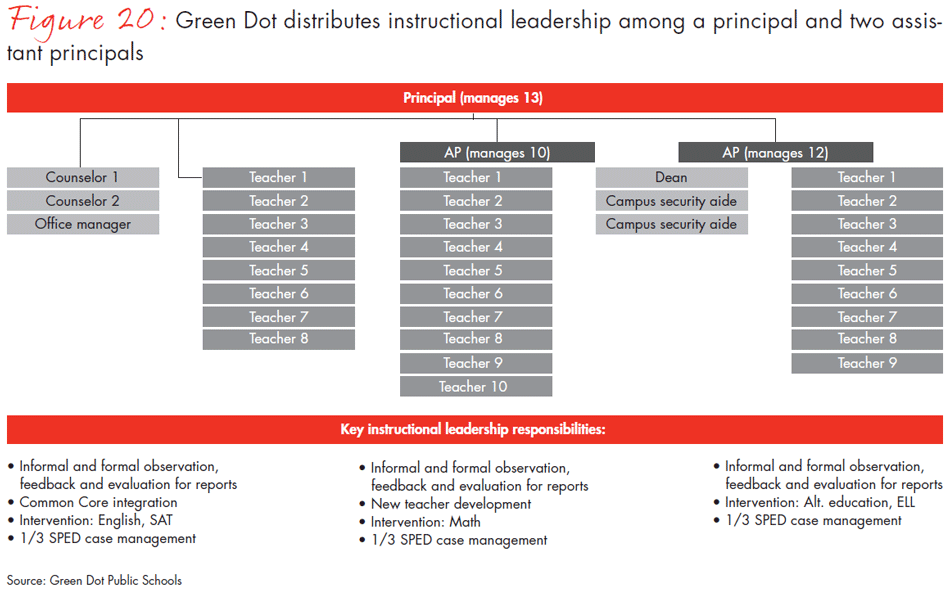
Other districts have chosen to boost leadership capacity by more fully empowering teacher leaders. The centerpiece of Denver’s distributed leadership model, for instance, is a teacher leader role called a Team Lead. It gives an experienced teacher up to 50% release time from classroom duties to work closely with a team of other teachers organized around a grade level or a subject area. The Team Lead is on point to observe and coach team members, provide input into their evaluations and share responsibility for their performance. Denver chose to focus on teacher leaders because it believed that current teachers would have the most credibility among their peers and would bring to the process the most relevant and up-to-date content expertise. Denver also believes that empowering such a group of “player coaches” promotes a healthy culture of teacher collaboration.
Perhaps not surprisingly, there is also a critical learning curve for principals when it comes to building more leadership capacity. One key to distributing leadership within a school building is that the principal has to get comfortable sharing responsibility with others. That requires becoming a leader of leaders rather than a leader of all—not always an easy shift. When the Team Leads in Denver began to take on more responsibility, for instance, some principals instinctively used their newfound “extra” time to double down on working with teachers they knew were struggling. Some had to learn to pull back and get out of the way. Their job in the new model was to coach and develop their Team Leads to handle those problems, not jump in themselves.
Emily Yates said the realization that she couldn’t do it all was a pivotal one. Yates is the principal at Sunshine Peak Academy, a Colorado school operated by the Knowledge Is Power Program (KIPP), a national charter school group. In her first year as principal, she was responsible for observing each of her 26 teachers nine times a year and providing all of their evaluations. This left little time for her to provide deeper mentoring and coaching to teachers. Sunshine Peak now has two APs who coach eight teachers each, typically within departments of the coach's expertise. To keep this number low for APs and also allow interested and experienced teachers to practice instructional coaching skills, Yates also created a roster of teacher leaders who are each responsible for coaching and evaluating one or two teachers. For Yates, the shift in focus and duties has been dramatic. She now spends most of her time coaching the coaches and helping them develop as instructional leaders. “That is absolutely the key,” she said. “The better my leaders get, the better my teachers get through them. Period. End of story. It raises the bar for performance across the whole school.”
Principle 3: Focus leaders on improving teaching and learning
The systems we’ve seen that are implementing distributed leadership models are putting more leaders closer to the front line. They are supporting teachers by observing and, at times, co-teaching in classrooms. They provide richer and more actionable feedback on instruction. Sometimes they’re just an ear and a motivating voice for a teacher after a tough day. As one KIPP Massachusetts principal describes: “You can’t just go in to a classroom and observe. You have to get your hands dirty.”
An effective distributed leadership model starts with an understanding that teaching is an incredibly difficult job—not just technically, but also emotionally. Nationwide, more than half our public school students qualify for free or reduced priced school lunch, nearly 10% of our students are English Language Learners and nearly 13% have some kind of disability. The challenges implicit in these numbers are often amplified in urban districts. Students bring their academic and broader life challenges to the classroom every day and teachers are on the front lines supporting them. Even in districts where conditions are less dire, the pressure to produce better results can be intense. The message is always the same: Student outcomes are not where they should be and teachers need to raise their game. If teachers are to improve against this backdrop, they need stronger support and better coaching from leaders who are invested in their success.
Districts like Denver are finding that the most effective coaching and mentorship involves not only one-to-one observation and feedback, but also time spent working together and collaborating to solve everyday problems. The focus is on helping teachers discover for themselves what works and what doesn’t in a highly supportive context—not telling them what to do or penalizing them for not doing it. As one experienced Team Lead in Denver explained, “I am in my teachers’ classrooms every week. I think about the big picture and what needs to change and then I think about small actions that will help us move forward and we focus together on those. In some classrooms, kids really aren’t clear on what they are supposed to be learning. I work with those teachers to make their objectives clear to kids and then we work together to plan their lessons to ensure they line up against those objectives.” Because she is with her teachers multiple times every week—working side-by-side with them on lesson planning, interpreting student data and watching them teach—she can base her feedback on a rich set of contexts and has the opportunity to develop relationships based on mutual trust and respect.
The power of relationships between leaders and teachers is the reason Green Dot has shifted its leadership emphasis from evaluation toward the broader challenge of supporting and developing teachers. Before the switch, Green Dot graded teachers on a scale of 1 to 4 using a standardized evaluation form with 29 indicators in five areas of teaching. Instead of supporting teachers and helping them solve problems, leaders spent a great deal of time sorting through the complex rubric and assigning scores. Teachers almost always received the same score (3 to 4) and they saw little in the way of valuable feedback or assistance.
“Our evaluation system was rigorous but had unintended consequences,” said Green Dot Chief Talent Officer Kelly Hurley. “It had become an all-consuming dog-and-pony show. The conversation was about the score, not improving performance.”
Green Dot is moving toward a system that prioritizes supporting and helping teachers grow over pure evaluation. It is steering leaders toward using the existing rubric to guide conversations about what teachers should be concentrating on and encouraging them to spend much more time interacting with the teachers they are responsible for leading. Cristina de Jesus, the CEO of Green Dot Public Schools California, said evaluation still has its place but there’s a critical difference—it has become more a measure of leadership support than a way to score teachers. “Evaluation is a dipstick,” de Jesus said. “We certainly still use it to determine teacher performance but are much more focused now in determining if the supports we are providing teachers are the right supports.”
The power of distributed leadership is that it sets our leaders up to provide the kind of hands-on, day-to-day coaching and support—real feedback, not a checklist—that will help teachers develop their skills and do what they came to do: make a real difference in their students’ lives. Many teachers invest heavily in their students, reveling in their successes and sharing the burden of their failures. But maintaining enthusiasm and energy for the job is a daily challenge. Too often, teachers see the limited guidance they get as punitive—a one-way, arms-length demand for better performance. The most effective school leaders understand this and see their roles as helping to create energy for teaching by ensuring teachers get the support they need. They look to fill teachers’ cups, not drain them, by directly and indirectly giving them valuable guidance, inspiration and mentorship. The most effective school leadership models position our leaders to do just that and ensure there are enough of them so every teacher gets the support he or she deserves.
Principle 4: Create teams with a shared mission
An essential part of strong leadership at the front line is building great teams and creating situations where team members can share knowledge, dissect problems together and work toward common goals. The most effective leaders understand that their role is not to be an all-knowing “Yoda,” but to inspire and build a shared commitment and capacity for great performance.
The typical school setup tends to encourage isolation more than team building and peer-to-peer learning. Teachers are primarily worried about their own classrooms, not what’s happening in the classroom across the hall. Sharing of ideas between grade levels or subject matter groups is typically serendipitous, not intentional. Most of the time, teachers are on their own—they report having only four hours a month to collaborate with other teachers.
An effective distributed leadership model breaks down those barriers by creating opportunities for teachers to work together—and an expectation that they will. As one leader at a KIPP school in Boston put it, “We teach in schools, not in classrooms. ‘No closed doors’ is part of our culture. Someone is always in your classroom. That’s just how it is.”
The most successful distributed leadership models match leaders to teams of teachers who serve a common purpose. Denver groups elementary school teachers together by grade level. It creates subject matter teams at the middle and high school levels (see Figure 21). Non-core subject area teachers are generally grouped together and, given a high enough concentration, special education teachers also form a team. What matters is that a team makes sense and is designed to foster peer-to-peer collaboration and a joint commitment to student outcomes.

Denver has designed its teams carefully to enable teacher leaders to personally mentor other teachers and lead by example. The model also helps leaders create opportunities for the team to do work together. That in turn helps build a culture of shared accountability such that team members feel responsible for the outcomes of all the kids taught by teachers on their team. Superintendent Boasberg believes this is a key part of Denver’s approach: “Our model is designed to increase peer-to-peer learning on teacher-led teams. The greater the commonality of interest among members, the more teachers learn from each other.”
In California, Sanger has been working on a PLC-based distributed leadership structure for over a decade and this kind of collaboration has become standard operating procedure. One high school teacher explained, “If you are a new teacher you are immediately led to your PLC leader and given all the tools you need along with incredible support. How you deliver is up to you, but you are part of a community. You are part of a family and they won’t let you fail.” Another teacher at Sanger’s Fairmont Elementary said, “We share a lot—even outside the meetings. We talk about and take what are best teaching practices and use them. There’s no seclusion—good teaching spreads very easily.” He credits the environment of trust and sharing to the school’s leaders. “They make it a positive experience. When we talk we aren’t complaining to each other; we are talking positively and sharing. They keep us focused on the students and teachers have the freedom and support to succeed.”
Principle 5: Empower leaders with the time and authority to lead
Having more leaders in our schools with true end-to-end responsibility for the development of our teachers is a key part of addressing the current leadership gaps: schools led by thinly stretched principals; too many isolated teachers who are not growing as instructors; and, ultimately, too many schools with poor student outcomes. But adding more leaders is only part of the answer. Systems must also set those leaders up for success with both the time and authority to effectively lead a team of teachers.
As we saw in Principle 2, some school systems are having success with a distributed leadership model that invests heavily in APs. They have increased the number of APs in their buildings, focused them on instructional leadership and given them the time to deliver, which frees them from the operating issues that all too often consume their days. The Dallas Independent School District, Green Dot and the three KIPP regions we studied (Colorado, Massachusetts and Los Angeles) are all good examples. These systems have been careful to prioritize and articulate the instructional leadership role they expect APs to play. They explicitly direct them to be in classrooms frequently—observing, providing high-quality coaching and working alongside their teams. They also hold them responsible for both development of the teachers they lead and for the outcomes of those teachers’ students. Dallas, under former Superintendent Mike Miles, added 163 APs—a 75% increase in two years—and Miles said the investment was critical: “We didn’t add to the budget. We prioritized. My priority was great leadership in schools.”
Green Dot CEO Marco Petruzzi said investing in more APs and empowering them to lead was essential to providing better instructional leadership. Green Dot isn’t spending more money per pupil, and actually operates in low-funding states, but it is prioritizing its spending differently to focus on adding APs. “In an ideal world, no one leader would have responsibility for more than 10 teachers,” Petruzzi said. “Working towards that, we probably have a higher ratio of APs to teachers than other schools our size but the investment is worth it for us. We want our APs and principals to have high-quality, development-focused relationships with the teachers in their buildings and, to do that, we simply need more of them.”
Green Dot has also called on teacher leaders to play many important roles in its schools, including observing other teachers and providing feedback. But it has chosen to invest more in AP capacity than teacher leader release time. Green Dot values teacher leadership but recognizes its limits absent the release time necessary to play a larger role. “We can’t and won’t hold them accountable for other teachers if we don’t give them time to do it,” said Green Dot California’s de Jesus. "We're still working on ways to make that happen, particularly for our turnaround schools, within our budget constraints."
Other school systems we studied are, however, betting heavily on teacher leaders to increase their instructional leadership capacity and are investing in providing more release time. Pilot programs launched by Denver, the Project L.I.F.T. schools in the Charlotte-Mecklenburg Schools (CMS) in North Carolina and the District of Columbia Public Schools, for instance, have all addressed the time issue by allowing teacher leaders to devote 50% or more of their schedule to non-classroom duties. Project L.I.F.T., a nonprofit public/private partnership, is one of five learning communities within CMS. Project L.I.F.T. worked with Public Impact, a North Carolina−based organization that partners with school systems to design and implement new leadership models. Together, Project L.I.F.T. and Public Impact worked with teachers and leaders in four CMS schools to implement Public Impact’s “Opportunity Culture” model. They started in 2013 and have added another school each year since. Teacher leaders in these schools have the freedom to adjust their own schedules so they can collaborate with their teams and co-teach alongside team members, “leading and developing them for success.” They have also boosted compensation significantly for those teacher leaders who have added significant new responsibilities (see Figure 22).
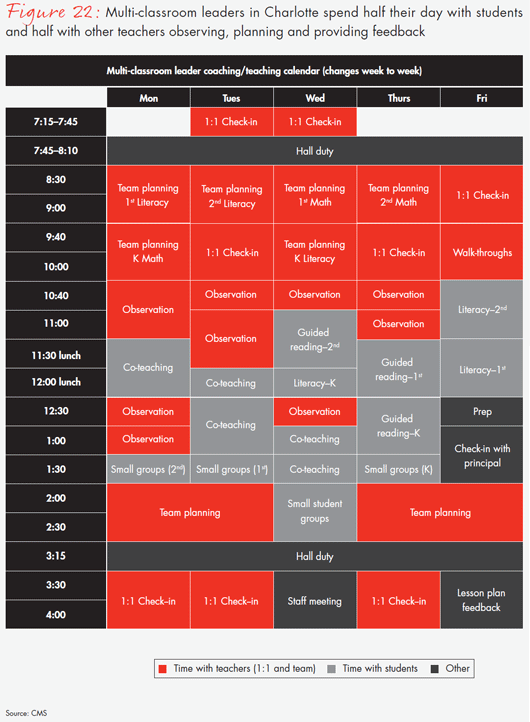
Efforts like these to define roles more intentionally and provide more time for working closely with teachers are an essential part of establishing an end-to-end distributed school leadership model. But it is also critical to empower new leaders with the authority they need to be successful. Principals need to be able to step back, delegate authority and focus on “leading a team of leaders.” That is generally more straightforward in an AP-centered model. The idea of an empowered AP role is broadly understood and accepted in most schools.
Empowering teacher leaders with the responsibility and authority to lead teams of their peers can be more challenging. In many schools there is a bias against the idea of teachers formally leading other teachers. Union agreements often present a challenge as well because of provisions preventing teachers from evaluating one another. As we’ve seen, however, this leads to a system where multiple parties play an uncoordinated role in a teacher’s development. That creates a lack of alignment between the guidance they provide and a teacher’s formal evaluation, leaving teachers without clear guidance on how to improve. “Empowering” is not synonymous with “evaluating.” But it’s hard to expect a leader to be responsible for the performance and development of a team of teachers without a meaningful role in their evaluation.
Without the appropriate authority, teacher leaders can make suggestions and they can try to work through influence, but they have no way to compel improvement if their recommendations go unheeded. Caleb Dolan, executive director of KIPP Massachusetts (KIPP:MA), describes the importance of teacher leaders having input into evaluation: “Divorcing evaluation from coaching seems so strange. If a teacher is progressing, the number at the end of the evaluation doesn’t really matter. If a teacher’s performance is problematic, they wouldn’t listen to the coach if the coach didn’t have evaluative input.” An assistant principal at KIPP:MA observed: “For too long, teaching has been a profession where teachers are not supposed to evaluate one another. So everyone else does. That needs to change. Doctors evaluate doctors, lawyers evaluate lawyers. Teachers can get together and hold each other accountable for outcomes. If you’ve spent hours and hours in my classroom observing, helping me plan, watching me grow, then what you have to say in my evaluation is valid and you are best able to articulate the right goals for me.”
Some school systems are succeeding in breaking down these barriers. In Denver, Team Leads who are responsible for up to eight other teachers have been given significant responsibility for their teams and empowered with the authority to play that role. “The overarching purpose of our Team Leads is to provide more coaching and feedback to the teacher. Our teachers know their Team Lead is empowered to lead their teams and that the Leads are working closely with the school leader. Teachers don’t have to guess whose direction and guidance is relevant for them,” said Superintendent Boasberg.
Project L.I.F.T.’s distributed leadership “Opportunity Culture” pilot schools in Charlotte have redesigned teacher jobs in which excellent teachers expand their impact, take on more responsibility and get paid more. “We very deliberately designed our model to keep our best teachers in the classroom but also to allow them to expand their impact,” explained Denise Watts, zone superintendent. “Our great teachers want to impact more than just their own students.”
The core leadership role in these Opportunity Culture schools is called a Multi-Classroom Leader (MCL). MCLs lead teams of teachers and are held directly accountable for the outcomes of all the students taught by the teachers on their team. While the principals still own evaluation, MCLs have explicit input into selection and evaluation of their peers, a right usually reserved only for those who have left the classroom. To support this significant shift, the CMS schools followed Public Impact’s guidance and went through a very deliberate and extensive design process to tailor the model for each school, building buy-in along the way. The teachers in those schools had input into the school model and have a clear understanding of how the model is different. As one teacher at Ranson IB Middle explained: “Over the past two years, having a colleague whose primary role is to support me and my teammates when we need support, and challenge us when we need to be pushed, has made a monumental difference in my well-being and my drive for success inside the classroom.”
The Academy for Urban School Leadership (AUSL), a nonprofit school management organization operating 32 Chicago public schools, has also made great strides in creating a fulsome distributed leadership model. AUSL’s approach has been to forge a culture of trust, collaboration and shared accountability for outcomes through its Instructional Leadership Teams (ILTs). “We have a culture of high expectations and the chain of leadership is strong at all levels,” said Dean Ashley Bias at the Dewey School of Excellence on Chicago’s South Side. “We don’t expect people to fly solo—we give and receive a lot of feedback—but we also hold one another responsible for delivering on commitments we make.”
For some, the threat of distributed leadership is that it creates more bosses and more bureaucracy. But a well-designed model for empowering more leaders actually has the opposite effect: Instead of a top-down system based on cursory evaluations and little individual support, distributed leadership invites collaboration, shared responsibility and a sense that we are all in this together on behalf of our students. “So much comes down to trust between teachers and administrators,” said one teacher at AUSL’s Casals School of Excellence. “Our team structure creates a way for us to come together, to build that trust and to focus on what it will really take to foster great teaching.”
There’s no doubt that implementing an effective distributed leadership model is a significant challenge for any school system. A number of those we’ve studied, in fact, haven’t moved forward because they don’t have a clear view of the right leadership model and aren’t sure how they’ll get there. But the experience of the systems that have made the greatest progress would suggest that it is not essential to have a “perfect” plan in place before getting started. As long as the goal is getting to a clear model, thoughtful piloting and iterating will lead in the right direction.
None of this is easy. It requires a multiyear, system-wide focus on change—restructuring roles, adjusting cultural norms and creating alignment around major shifts in how schools are organized and run. Yet our research over the past year has left us energized and optimistic. We’ve seen districts and CMOs making real investments in developing and deploying transformative leadership in their schools and we’ve seen tangible evidence of success. While this work is in its early days, momentum is building and we are hopeful that this report offers a set of lessons to help guide others interested in embarking on the journey. Today, there are millions of teachers and school leaders doing our nation’s most important work—preparing the next generation for the opportunities and challenges ahead. It is critical that we empower them with the skills and supports needed to get this job done.
Moving to a distributed leadership model
After studying what’s working among the school systems involved in our research, we’ve been able to assemble a set of best practices that are common to those having the most success along this journey. These systems start by designing an initial model—or set of models—that establish key leadership roles, how those roles will be deployed to support teams of teachers and what processes the system will need to support the new structure. They then pilot and refine these models, gathering feedback from stakeholders and making improvements based on what they learn. Finally, they decide on a winning model and position it for scale, by establishing standards and aligning support structures across the system.
Here is what a successful, phased effort might look like:
Phase 1: Design
- Identify and form a working team to develop your pilots
- Set clear objectives and define specific measures of success for the next few years
- Design a prototype including key leadership roles, how they will be deployed to support teams of teachers, and what systems and processes you’ll need to support your structure
- Set a timeline with goals for piloting, expanding your pilot and rolling it out more broadly
- Engage stakeholders throughout the system to review the proposed model and offer input
Phase 2: Pilot and refine
- Select capable school leaders who are excited to develop the pilots
- Establish mechanisms to gather and incorporate feedback and results
- Gather and share best practices, using what you learn to refine the model
- Generate interest and roll out a second wave of pilots
Phase 3: Roll out system-wide
- Define which parts of the model should be standardized and which can be customized at the school level
- Determine sustainable funding
- Create a roadmap for rolling out the model to all schools, including plans for communication and change management
- Build system-wide alignment around the necessary support structures
- Rigorously assess the strength of your model and the systems and processes that support it. Make continuous improvement a core tenet of the transformation
Chris Bierly is a Bain partner based in Boston and is the global head of Bain’s K-12 Education practice. He has more than 25 years of management consulting experience, advising clients across the private, public and nonprofit sectors. Betsy Doyle is a partner in Bridgespan’s San Francisco office and is a leader in its Education practice. Her work focuses primarily on improving educator development and retention, scaling high-performing school models and supporting effective education philanthropy. Abigail Smith is a Bain principal based in San Francisco and is a core leader of Bain’s K-12 Education practice. Prior to Bain she was a high school math teacher at a large urban public school.




















